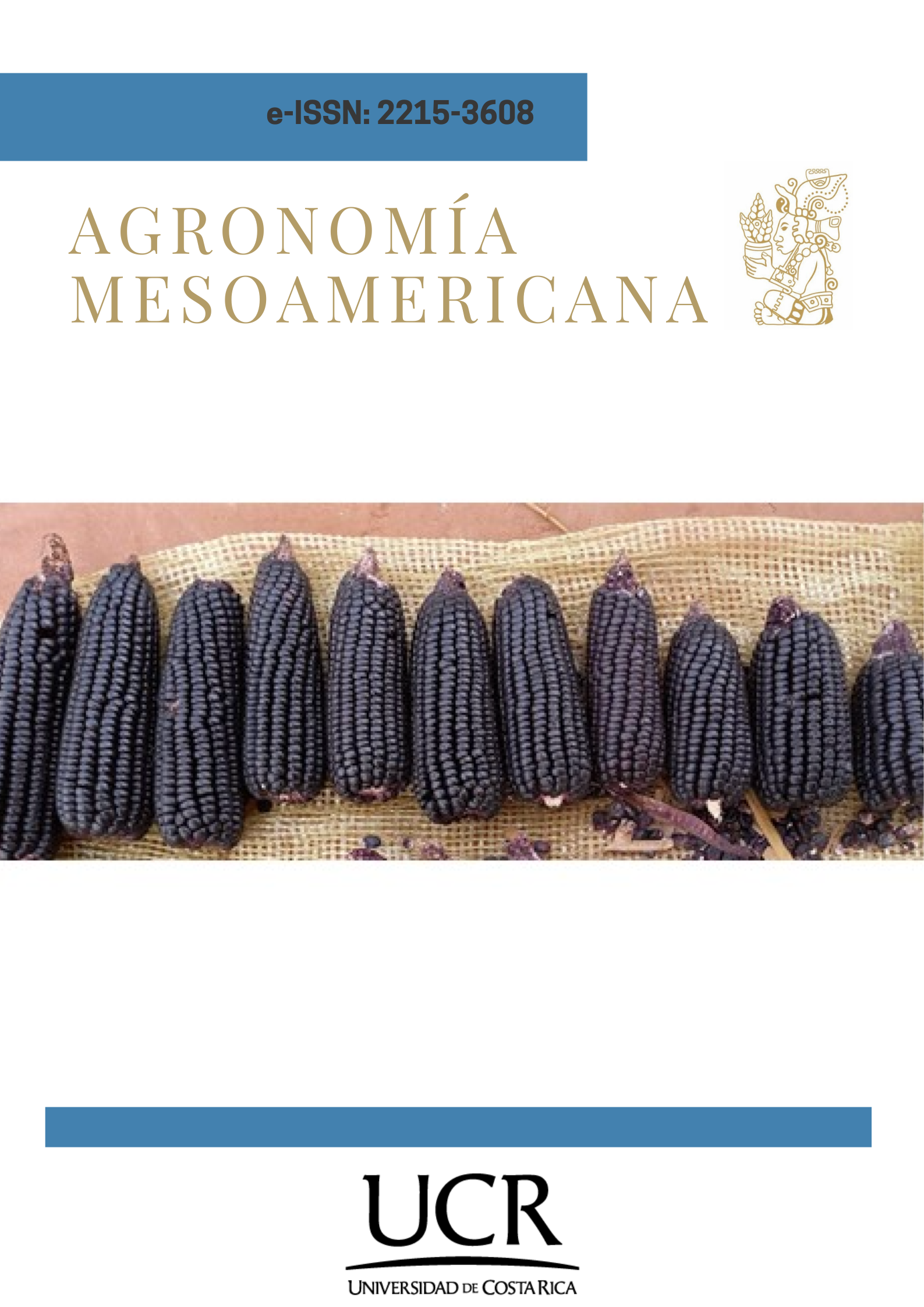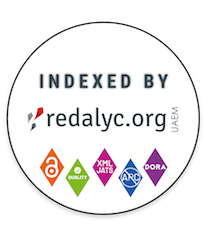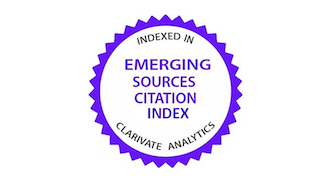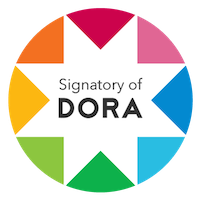Exploratory single crosses of purple maize for pericarp and cob pigment production
DOI:
https://doi.org/10.15517/am.2025.61186Keywords:
Anthocyanins, hybridization, population improvement, Zea Mays L.Abstract
Introduction. Plant pigments represent an alternative to artificial colorants and contribute to the consumption of healthier foods. Objective. To evaluate, both in field and laboratory, exploratory single crosses (ESCs) of maize purple grain and cob developed using random lines, to assess the integration of the heterotic pattern B-49N x B-41N. Material and methods. The research was conducted in Tepatitlán, Jalisco, Mexico, during 2021 and 2022. ESCs were formed using six S5 lines from the B-49N population and four S3 lines from B-41N, all with purple grain and cob. In 2022, the crosses and five controls were evaluated under rainfed conditions in the same location, using a randomized complete block experimental design with three replications. Each plot consisted of a single row, 4 m long, 0.8 m wide, and 0.16 m between plants, with 25 plants per row. Data were collected on plant and ear characteristics. Total anthocyanin content in grain (CATg) and cob (CATo) was measured in seven of the crosses. Analysis of variance and mean comparison tests were conducted for all variables using SAS statistical software. Results. Twelve ESCs were identified with grain yield equal (p < 0.05) to the white control, but with purple grain and cob. Significant variation (p < 0.05) was observed in days to anthesis (ranging from 80 to 90 days), stalk lodging (from 0 to 12.6 %), and ear scoring (from 1.5 to 2.7). Grain texture ranged from soft to very soft among the ESCs. No association was found between grain yield and levels of CATg and CATo. Conclusion. The results from the ESCs indicate positive progress in the integration of the purple maize heterotic pattern B-49N x B-41N. However, future efforts should focus on increasing anthocyanin content in grain and cob, as well as improving grain hardness.
Downloads
References
Aguilar-Hernández, Á. D., Salinas-Moreno, Y., Ramírez-Díaz, J. L., Alemán-De la Torre, I., Bautista-Ramírez, E., & Flores-López, H. E. (2019). Antocianinas y color en grano y olote de maíz morado peruano cultivado en Jalisco, México. Revista Mexicana de Ciencias Agrícolas, 10(5), 1071–1082. https://doi.org/10.29312/remexca.v10i5.1828
Arellano Vázquez, J. L., Herrera Zamora, A., Gutiérrez Hernández, G. F., Ceja Torres, L. F., & Flores Gómez, E. (2021). Color, contenido de antocianinas y dimensiones de semilla en líneas endogámicas de maíz azul y sus cruzas. Idesia (Arica), 39(3), 75–82. https://dx.doi.org/10.4067/S0718-34292021000300075
Basu, A., & Kumar, G. S. (2014). Study on the interaction of the toxic food additive carmoisine with serum albumins: A microcalorimetric investigation. Journal of Hazardous Materials, 273, 200–206. https://doi.org/10.1016/j.jhazmat.2014.03.049
De Nisi, P., Borlini, G., Parizad, P. A., Scarafoni, A., Sandroni, P., Cassani, E., & Pilu, R. (2021). Biorefinery approach applied to the valorization of purple corn cobs. Sustainable Chemistry and Engineering, 9(10), 3781–3791. https://doi.org/10.1021/acssuschemeng.0c08717
García-Lara, S., Chuck-Hernandez, C., & Serna-Saldivar, S. O. (2019). Development and structure of the corn kernel. In S. O. Serna-Saldivar (Ed.), Corn (3rd ed., pp. 147–163). AACC International Press. https://doi.org/10.1016/B978-0-12-811971-6.00006-1
Gerde, J. A., Tamagno, S., Di Paola, J. C., & Borrás, L. (2016). Genotype and nitrogen effects over maize kernel hardness and endosperm zein profiles. Crop Science, 56(3), 1225–1233. https://doi.org/10.2135/cropsci2015.08.0526
Harakotr, B., Suriharn, B., Lertrat, K., & Scott, M. P. (2016). Genetic analysis of anthocyanin content in purple waxy corn (Zea mays L. var. ceratina Kulesh) kernel and cob. SABRAO Journal of Breeding and Genetics, 48(2), 230-239. https://dr.lib.iastate.edu/server/api/core/bitstreams/94785693-a44a-4157-9482-0936d9040e5e/content
Ibarra Sánchez, E., Castillo Gutiérrez, A., Núñez Valdéz, M. E., Suárez Rodríguez, R., Andrade Rodríguez, M., & Perdomo Roldán, F. (2020). Caracterización de la respuesta a la sequía de líneas segregantes de maíz. Revista Mexicana de Ciencias Agrícolas, 11(7), 1511–1524. https://doi.org/10.29312/remexca.v11i7.2196
Jing, P., Noriega, V., Schwuartz, S. J., & Giusti, M. M. (2007). Effects of growing conditions on purple corn cob. Journal of Agriculture and Food Chemistry, 55(21), 8625–8629. https://doi.org/10.1021/jf070755q
Khamphasan, P., Lomthaisong, K., Harakotr, B., Scott, M. P., Lertrat, K., & Suriharn, B. (2020). Effects of mass selection on husk and cob color in five purple field corn populations segregating for purple husks. Agriculture, 10(8), Article 311. https://doi.org/10.3390/agriculture10080311
Ledesma-Miramontes, A., Salinas-Moreno, Y., Ramírez-Díaz, J. L., & Alemán-de la Torre, I. (2022). Contenido de antocianinas en mestizos de maíz morado sometidos al proceso de perlado del grano. Acta Fitogenética, 8(1), 59. https://www.somefi.mx/wp-content/uploads/2022/11/ACTA_MAICES_2022_Chiapas_Noviembre.pdf
Macke, A. J., Bohn, O. M., Rausch, D. K., & Mumm, H. R. (2016). Genetic factors underlying dry-milling efficiency and flaking-grit yield examined in the US maize germplasm. Crop Science, 56(5), 2516–2526. https://doi.org/10.2135/cropsci2016.01.0024
Márquez-Sánchez, F. (1990). Backcross theory for maize. I. Homozygosis and heterosis. Maydica, 35, 17-22.
Mendoza-Mendoza, C. G., Mendoza-Castillo, M. del C., Delgado-Alvarado, A., Castillo-González, F., Kato-Yamakake, T. A., & Cruz Izquierdo, S. (2017). Antocianinas totales y parámetros de color en líneas de maíz morado. Revista Fitotecnia Mexicana, 40(4), 471–485. https://revfitotecnia.mx/index.php/RFM/article/view/185/163
Mendoza-Mendoza, C. G., Mendoza-Castillo, M. del C., Castillo-González, F., Sánchez-Ramírez, F. J., Delgado-Alvarado, A., & Pecina-Martínez, A. (2019). Agronomic performance and grain yield of Mexican purple corn populations from Ixtenco, Tlaxcala. Maydica, 64(3), 1–9. https://journals-crea.4science.it/index.php/maydica/article/view/1947
Paulsmeyer, M., Chatham, L., Becker, T., West, M., West, L., & Juvik, J. (2017). Survey of anthocyanin composition and concentration in diverse maize germplasms. Journal of Agricultural and Food Chemistry, 65(21), 4341–4350. https://doi.org/10.1021/acs.jafc.7b00771
Ramírez Díaz, J. L., Salinas Moreno, Y., Alemán de la Torre, I., Bautista-Ramírez, E., & Esquivel Esquivel, G. (2019). Aptitud combinatoria en líneas de maíz pigmentado. Acta Fitogenética, 6(1), 30. https://www.somefi.mx/wp-content/uploads/2019/11/ACTA6_6Nov_opt.pdf
Ramírez Díaz, J. L., Salinas Moreno., Y., Alemán de la Torre, I., Esquivel Esquivel, G., & Vidal Martínez, V. A. (2017). Formación de un patrón heterótico de maíz para producción de pigmentos en olote y el pericarpio del grano. Acta Fitogenética, 4(1), 19. https://www.somefi.mx/wp-content/uploads/2017/12/Acta-Fitogenetica-Vol-4.-2017.-29-Agosto.pdf
Ramírez-Díaz, J. L., Chuela-Bonaparte, M., Vidal-Martínez, V. A., Vallejo-Delgado, H. L., Ramírez-Zamora, R., Peña-Ramos, A., Ortega-Corona, A., Córdova-Orellana, H., Morfín-Valencia, A., Gómez-Montiel, N. O., Caballero-Hernández, F., Ramírez-Márquez, M., Vázquez-Carrillo, M. G., Ruíz-Corral, A., Ron-Parra, J., Sánchez González, J. J., & Soltero-Díaz, L. (2010). H-377. Híbrido de maíz de grano blanco para riego y buen temporal para la zona centro occidente de México (Folleto Técnico No. 3). Instituto Nacional de Investigaciones Forestales, Agrícolas y Pecuarias.
Ramírez-Díaz, J. L., Ledesma-Miramontes, A., Vidal-Martínez, V. A., Gómez-Montiel, N. O., Ruiz-Corral, J. A., Velázquez-Cardelas, G. A., Ron-Parra, J., Salinas-Moreno, Y., & Nájera-Calvo, L. A. (2015). Selección de maíces nativos como donadores de características agronómicas útiles en híbridos comerciales. Revista Fitotecnia Mexicana, 38(2), 119–131. https://revfitotecnia.mx/index.php/RFM/article/view/410/377
Ramírez-Díaz, J. L., Salinas-Moreno, Y., Ledesma-Miramontes, A., & Alemán-de la Torre, I. (2022). Formación de un patrón heterótico de maíz morado: Generación de la población B-49N. Acta Fitogenética, 8(1), 54. https://www.somefi.mx/wp-content/uploads/2022/11/ACTA_MAICES_2022_Chiapas_Noviembre.pdf
Rebolloza-Hernández, H., Cervantes-Adame, Y. F., Broa-Rojas, E., Bahena-Delgado, G., & Olver-Velona, A. (2020). Fenotipeo y selección de líneas S1 segregantes de maíz tolerantes a estrés hídrico. Biotecnia, 22(3), 20–28. https://biotecnia.unison.mx/index.php/biotecnia/article/view/1130/448
Ron-Parra, J., Morales-Rivera, M. M., Jiménez-López, J., Jiménez-Cordero, Á. A., De la Cruz-Larios, L., & Sánchez-González, J. J. (2016). Maternal genetic inheritance of red pericarp in the grain of maize. Maydica Electronic Publication, 61, 1–5. http://core.ac.uk/download/pdf/230662999.pdf
Salinas, Y., Esquivel, G., Ramírez, J. L., & Alemán, I. (2016). Selección y evaluación de poblaciones nativas de maíz con potencial para la extracción de pigmentos (Folleto Técnico No. 7). Instituto Nacional de Investigaciones Forestales, Agrícolas y Pecuarias.
Salinas, Y., & Vázquez, G. (2006). Metodologías de análisis de la calidad nixtamalera-tortillera en maíz (Folleto Técnico No. 23). Instituto Nacional de Investigaciones Forestales, Agrícolas y Pecuarias.
Salinas Moreno, Y., Salas Sánchez, G., Rubio Hernández, D., & Ramos Lobato, N. (2005). Characterization of anthocyanin extracts from maize kernels. Journal of Chromatographic Science, 43, 483–487. https://doi.org/10.1093/chromsci/43.9.483
Salinas-Moreno, Y., Esquivel-Esquivel, G., Ramírez-Díaz, J. L., Alemán-de la Torre, I., Bautista-Ramírez, E., & Santillán-Fernández, A. (2021). Selección de germoplasma de maíz morado (Zea mays L.) con potencial para extracción de pigmentos. Revista Fitotecnia Mexicana, 44, 309–321. https://doi.org/10.35196/rfm.2021.3.309
Sheoran, S., Kaur, Y., Kumar, S., Shukla, S., Rakshit, S., & Kumar, R. (2022). Recent advances for drought stress tolerance in maize (Zea mays L.): Present status and future prospects. Frontiers in Plant Science, 13, Article 872566. https://doi.org/10.3389/fpls.2022.872566
Statistical Analysis System. (2009). SAS/STAT® 9.2 User’s guide (2nd ed.). SAS Institute Inc. https://bit.ly/3XkrzFE
Urias-Lugo, D. A., Heredia, J. B., Valdez-Torres, J. B., Muy-Rangel, M. D., Serna-Saldivar, S. O., & García-Lara, S. (2015). Physical properties and chemical characterization of macro-and micronutriments of elite blue maize hybrids (Zea mays L). Cereal Research Communications, 43(2), 295–306. https://doi.org/10.1556/crc.2014.0044
Xu, D., Mei, X., Yu, T., Yuan, W., Gu, D., Liu, X., & Cai, Y. (2015). Further mapping and epistasis analysis of two quantitative trait loci of kernel and cob anthocyanin contents in maize. Crop Science, 56(1), 12–18. https://doi.org/10.2135/cropsci2015.04.0201
Xue, J., Xie, R.-z., Zhang, W.-f., Wang, K.-r., Hou, P., Ming, B., Gou, L., & Li., S. (2017). Research progress on reduced lodging of high-yield and-density maize. Journal of Integrative Agriculture, 6(12), 2717–2725. https://doi.org/10.1016/S2095-3119(17)61785-4

Downloads
Additional Files
Published
How to Cite
Issue
Section
License
Copyright (c) 2025 José Luis Ramírez Díaz, Alejandro Ledesma Miramontes, Yolanda Salinas Moreno, Ivone Alemán de la Torre, Thanda Dhliwayo, Víctor Antonio Vidal Martínez

This work is licensed under a Creative Commons Attribution-NonCommercial-NoDerivatives 4.0 International License.
1. Proposed policy for open access journals
Authors who publish in this journal accept the following conditions:
a. Authors retain the copyright and assign to the journal the right to the first publication, with the work registered under the attribution, non-commercial and no-derivative license from Creative Commons, which allows third parties to use what has been published as long as they mention the authorship of the work and upon first publication in this journal, the work may not be used for commercial purposes and the publications may not be used to remix, transform or create another work.
b. Authors may enter into additional independent contractual arrangements for the non-exclusive distribution of the version of the article published in this journal (e.g., including it in an institutional repository or publishing it in a book) provided that they clearly indicate that the work was first published in this journal.
c. Authors are permitted and encouraged to publish their work on the Internet (e.g. on institutional or personal pages) before and during the review and publication process, as it may lead to productive exchanges and faster and wider dissemination of published work (see The Effect of Open Access).























